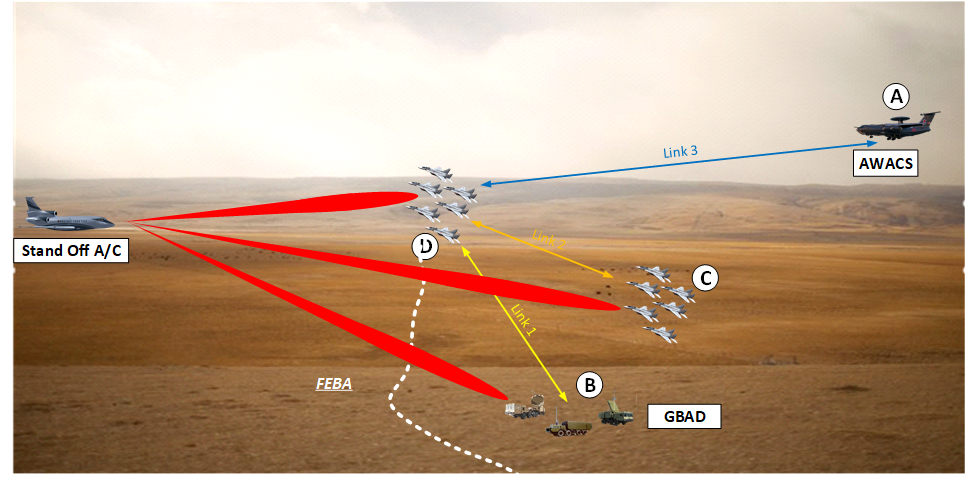Communication Electronic Counter Measures in Stand-off Jammer Task
In terms of operating platforms, the CECM exploits its capability either on Stand-Off or Stand-In platforms, respectively with the specific deployed jammer.
The jamming signal can interfere, according to the strength with which it affects the victim receiver with BER (BIT Error Rate) over the received signal for digital communication, or it can simply impair the analogue communications generating a quite high Jammer to Signal ratio (JSR) in order to desensitize the radio’s receiver.
In addition, the in-band jammer signal can impair the receiver’s clock recovery and bearer synchronization circuits, till to saturation, distortion or permanent damage of the receiver circuits, especially if not protected with adequate filtering devices (in term of robustness and selectivity).
Electronic Warfare Systems, specifically conceived for disturbing or damaging enemy’s telecommunication systems, put the ECMs actions in act. An operational example of a jammer attack is shown in Figure 1.
A possible classification of electromagnetic actions (Electronic Counter Measures) can be defined according to their main peculiarity:
- Jamming: the following jammers can be listed: Barrage jammers, Noise Modulated FM (Random electronic noise that appears at the receiver as background noise and tends to mask the desired radar echo or radio signal), CW (Continuous Wave) tones jammers, Sweep jammers, Follower jammers. Jammer signals can be pulsed or Continuous Wave (CW).
- Interception and listening (ES support to the ECM action): the interception and listening action consists in the radio signals detection and the recognition of its spatial characteristics (direction and distance), spectral characteristics (frequency, modulation type etc.) and information content.
- Deception: the deception action consists in the transmission of signal as similar as possible to the original source. Its intensity must be sufficient to overwhelm the transceiver and to “deceive” the receiver for synchronizing with the “false” transmitter with no evidence of the replacement, at waveform level.
- Physical Neutralization (RF Direct energy Weapon): the neutralization caused by a non-repairable damage to a telecommunication system can be carried out applying an energy level sufficient to cause some critical component disruption.
The energy is usually applied by means of pulses of variable duration and very high amplitude, also reaching the order of magnitude of Giga Watts.

Figure 1: SOJ typical air-to-air and air-to-ground scenario
The effectiveness of the CECM depends on several factors:
- Distance from the victim radio link[*] ;
- The level of the generated jamming;
- The geographical constraints (obstacles, terrain);
- The duration of the service under threat;
- The intrinsic Electronic Protection measures of the attacked radios.
[*]Note: Influence of SOJ position in distance latency evaluation
The main factor influencing the efficiency of the jamming action is surely the distance of the jammer from the victim radio link.
The first reason of that is related to the power to be transmitted that will decrease as soon as the jammer gets closer to the radio link (with very positive impact on transmitter SWAP, but with increasing risk for the carrier platform).
The second reason is related to propagation time: the delay of the jamming action is heavily influenced by the position of the COMMJAM with respect to the victim radio link.
Modern radio link use, as ECCM, frequency hopping strategies (the frequency of the carrier is changed any xx fractions of second, for instance in case of 4000 hops per second it will be any 250 μsec).
In most of the cases, this will impede the use of the follower jamming (follower jamming consists in reception and re-transmission of the signal, with or without modulation superimposed, that allows to reply with coherent signals positioned inside the hop).
For instance for a SOJ A/C positioned at 100 Km from the radio link to be jammed the propagation delay will be 667 μsec.
Taking into account that a further delay for the jammer intrinsic response time must be added, the maximum hop that can be jammed is about 500 hops per second.
Faster hops will require the use of techniques like TDM (Time Division Multiplexing) or FDM (Frequency Division Multiplexing).
- Every doubling of TDM cardinality still provides the same peak power but reduces the time persistence on the single target by a factor of two.
- Every doubling of FDM cardinality still provides the same time persistence on the single target frequency but reduces the peak output power per target frequency by 6dB.






